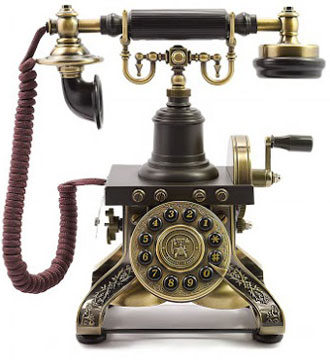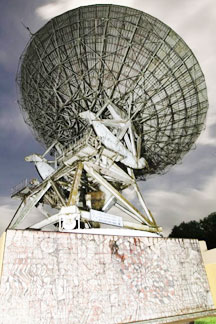Telecom Museum: A call from the past to the future
By Ryhaana Sallie
 If you hear the two words, telecom and Padukka together, you will
most probably think of only one thing - the giant satellite dish that
was Sri Lanka’s only gateway to the rest of the world until the modern
Internet-based telecom age began. It is famous as the only place where
Sri Lanka could get access to live pictures from the Moon exactly 47
years ago, on July 20, 1969 during the first Moon landing. If you hear the two words, telecom and Padukka together, you will
most probably think of only one thing - the giant satellite dish that
was Sri Lanka’s only gateway to the rest of the world until the modern
Internet-based telecom age began. It is famous as the only place where
Sri Lanka could get access to live pictures from the Moon exactly 47
years ago, on July 20, 1969 during the first Moon landing.
But, that is not all. Sri Lanka Telecom has now converted that iconic
satellite station into a museum – the country’s first and only National
Telecommunications Museum. It showcases Sri Lanka’s progress in the
telecom sector right from the days of Alexander Graham Bell, and even
earlier – from 1857, when the Ceylon Telegraph Department was
established. The museum has some of the earliest examples of telephones
that were used during this period and many other telecom equipment
numbering over 500 from an early Morse Code transmitter to old manual
telephone exchanges. It is in fact, South Asia’s largest telecom museum.
The Telecom Museum, which opened its doors to the public in May this
year, tells a fascinating story. In 1858, the first telegraphic circuit
was constructed between Galle and Colombo. This pioneering effort
consisted of a 74-mile long telegraph line stretching between the two
town centres, using the ubiquitous coconut trees in place of telegraph
poles. The technology used was that of the needle telegraph, invented by
Cooke and Wheatstone. From 1864 to 1878, telegraph lines were extended
from Kandy through Dambulla to Trincomalee and from Colombo to Nuwara
Eliya, Jaffna, Badulla, Batticaloa and Panadura.
The first international telegraph link was established between Ceylon
and India.
 In 1880, the Post and Telegraph Department was established
amalgamating the two services under the control of the Government of
Ceylon. The first telephone lines were installed in 1881 by the Oriental
Telephone Company. In 1880, the Post and Telegraph Department was established
amalgamating the two services under the control of the Government of
Ceylon. The first telephone lines were installed in 1881 by the Oriental
Telephone Company.
Microwave link
The Central Telegraph Office (CTO) building was opened in 1911. The
following year, the Colombo Wireless Telegraph Station was set up and
opened to the public. In 1935 - The first international telephone link
was commissioned between Ceylon and India. Just four years later,
Colombo’s Central Exchange went automatic.
International operations were handed over to the Cable & Wireless
Company of England in 1941, but upon gaining independence in 1948, its
operations were taken over by the Post and Telecommunications Department
of Ceylon in 1951.
Subscriber Trunk Dialling (STD) services were introduced in 1968, and
Sri Lanka’s first satellite earth station (Standard A) was commissioned
at Padukka.
In 1980, Postal and Telegraph services were separated, and the
Department of Telecommunications established, and International Direct
Dialling (IDD) services were introduced.
In 1981, the first digital master exchange was installed.
The following year, a microwave link was set up between India and Sri
Lanka. The first fibre optic cable was laid in 1986. The cable was
commissioned to link Primrose Hill Microwave Radio Terminal Station to
the Kandy Transmission Station. The graded index cable carried three 34
Mbps systems to provide 512 digital channels. As technology improved
with time, the utilization of fibre optic cables for inland
communication grew rapidly, and by 1989, 140 Mbps systems were
introduced in the Colombo metropolitan area.
The first mobile telephone licence was issued in 1988.
Digital packet switching service was introduced in the 1990s. In
1993, Mobitel was established as a joint venture between SLT and Telstra
Australia. A fully digital Standard A satellite earth station was
commissioned at Padukka in 1995. Sri Lanka Telecom was privatized in
1997. Nippon Telegraph & Telephone Corporation (NTT) of Japan became
SLT’s strategic partner. Just two years later, SLT installed its
500,000th telephone connection. By 2000, the first optical fibre
transmission ring connected 15 cities.
SLT launched CDMA telephone in 2005.
SLT welcomed its one-millionth customer a few months later. In 2007,
SLT launched Peo TV (Sri Lanka’s first IPTV service). By 2010, SLT
expanded the fibre optic information superhighway to the Northern
Peninsula, reaching the 200,000th Broadband customer milestone.
SLT’s 100Mbps super-fast broadband internet went live in Sri Lanka in
2012. SLT launched fixed 4G/LTE technology in 2014, while partnering 15
global telcoms to connect continents via SEA-ME-WE 5 submarine cable
system. SLT launched world class ‘Carrier-grade’ public Wi-Fi ‘hotspots’
for the first time in the country. SLT also launched 100G Ultra Speed
National Backbone Network.
A visit to the Telecom Museum in Padukka is a must for all telecom
enthusiasts and also for students who are keen to learn about the
history of telecommunications in Sri Lanka from the 1870s to the present
day. It is located on the Meepe-Bope Road, close to the Meepe junction
with easy access by public and private transport.
It is open from 9 a.m. to 4 p.m. Monday to Saturday. You can reserve
a tour online or if you can’t go there, you can take a virtual tour at
slt.lk.
Climate controlled
If you have unused old telecom equipment lying around in your home or
office, you can donate them to the museum for posterity, where they will
be kept in climate controlled conditions for years to come.
All the exhibits in the museum are originals, not reproductions and
some of them are still in working condition, though modern (digital)
technology has progressed beyond their lifespan. It is a fascinating
glimpse into the past and a harbinger of a high-tech future.
|

